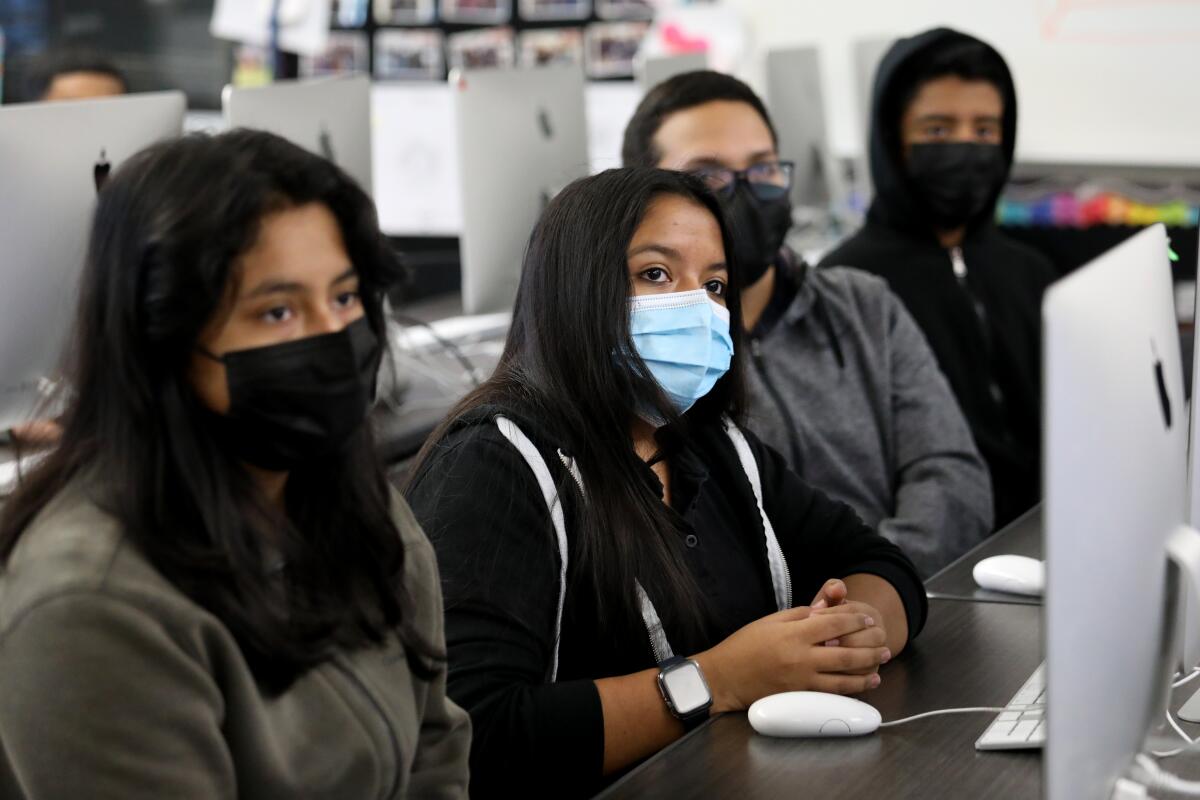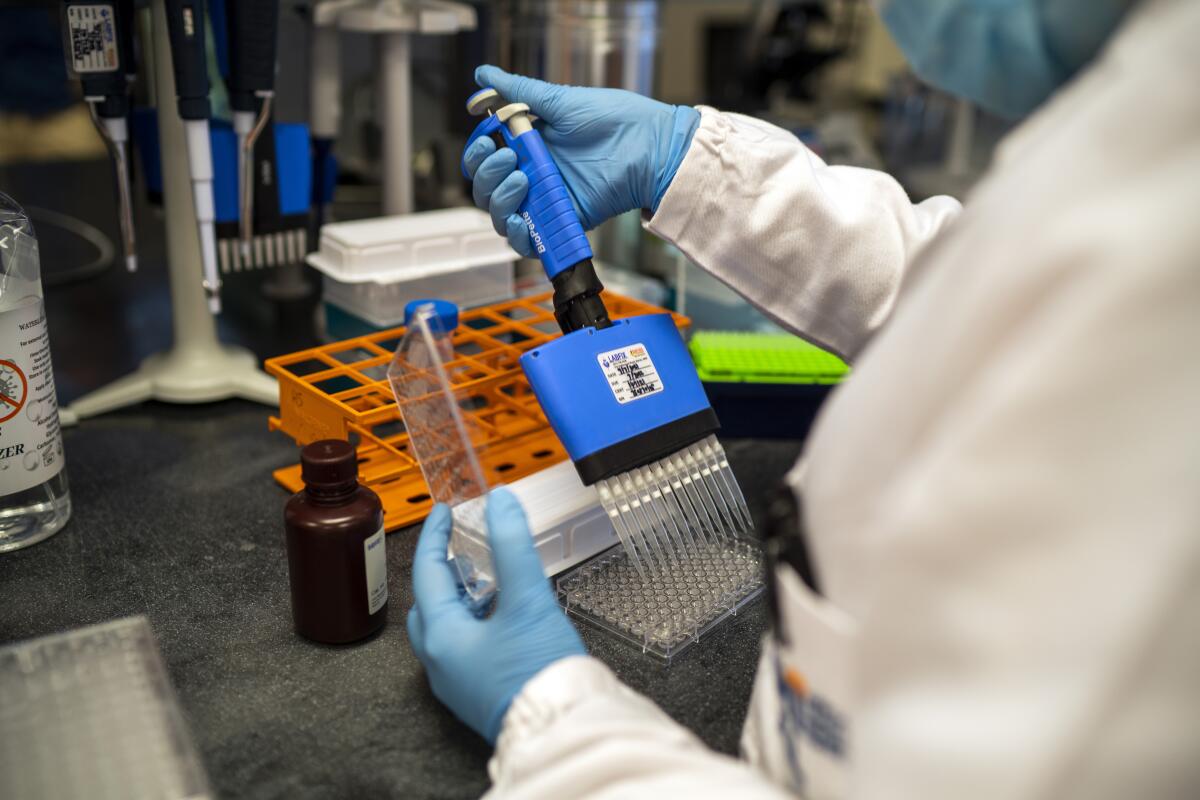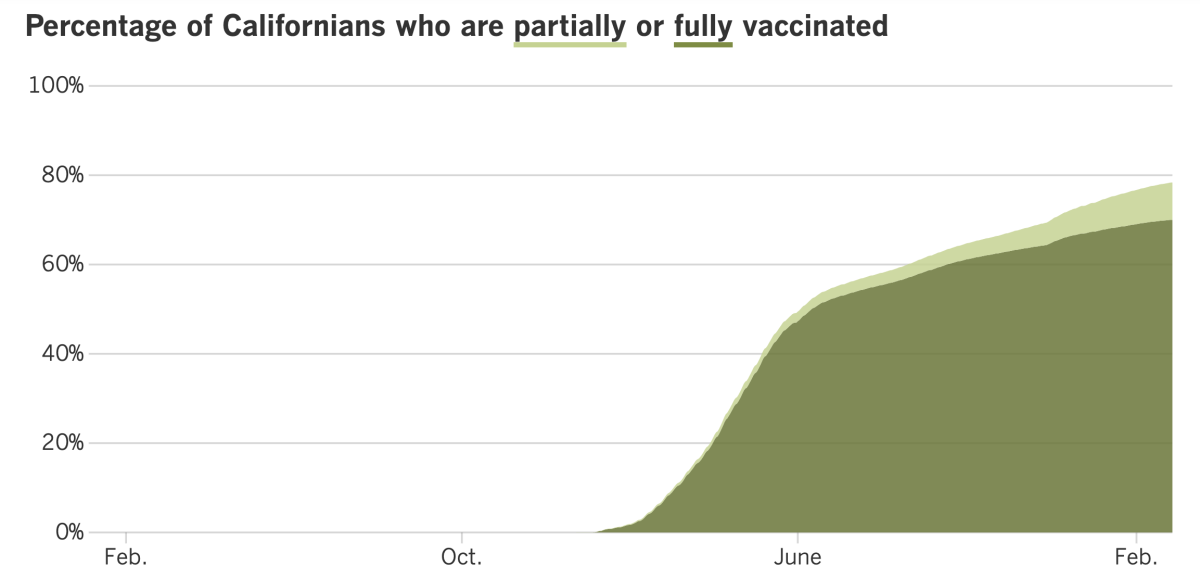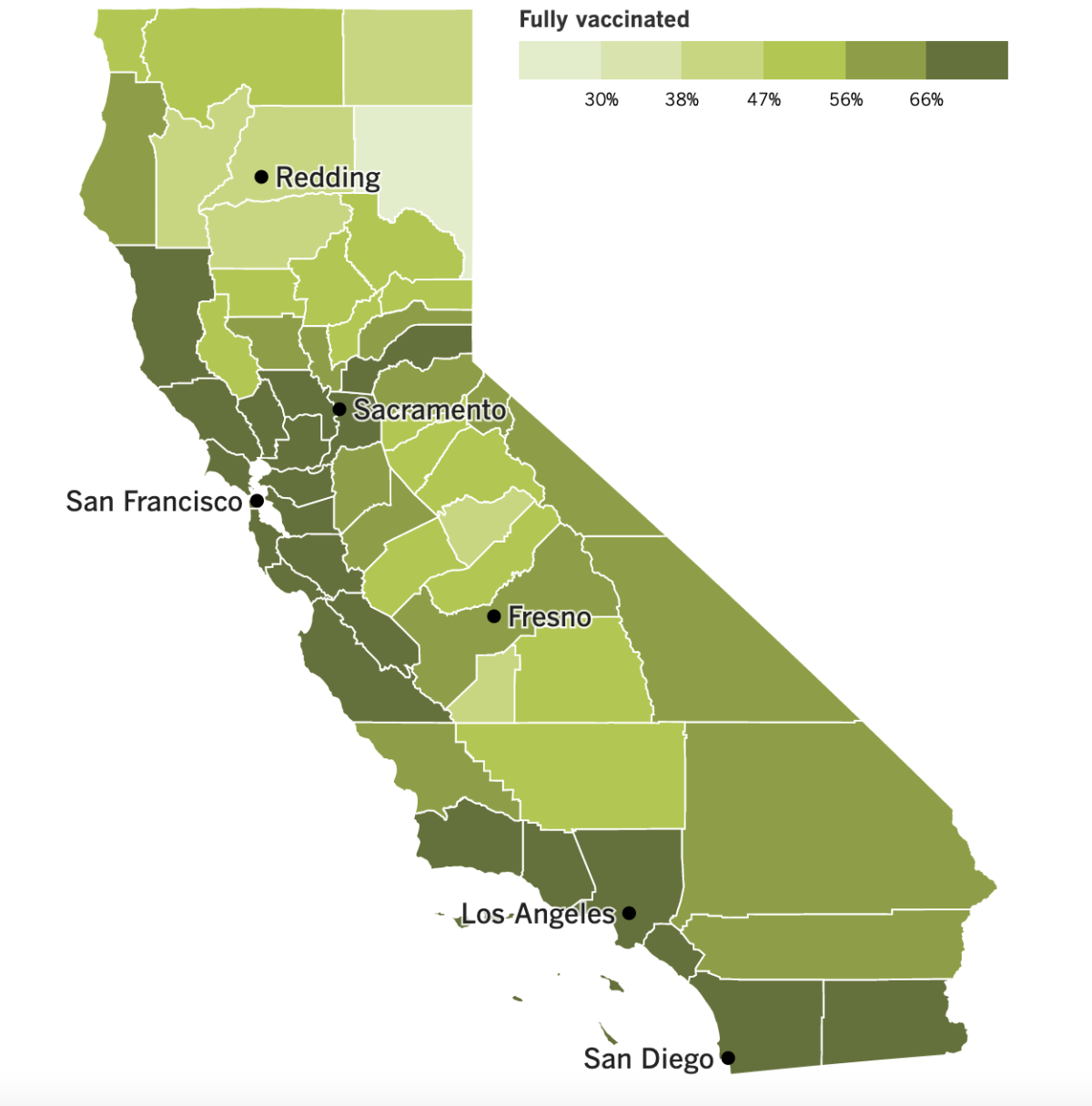Coronavirus Today: To mask or not to mask
- Share via
Good evening. I’m Karen Kaplan, and it’s Tuesday, March 1. Here’s the latest on what’s happening with the coronavirus in California and beyond.
For some of us, the pandemic is about to enter a more tolerable phase. And for some of us, our daily lives are going to include a lot more stress.
In both cases, the reason is the same: More mask mandates are falling away.
Even in California, which has adopted some of the country’s most aggressive COVID-19 safety polices, the message on masks is shifting.
On Monday, state health officials announced that Sacramento would no longer require anyone to to wear masks in most indoor settings. That includes people who haven’t received a single dose of COVID-19 vaccine. The new state policy went into effect today.
Officials also announced that the state would no longer make kids or adults wear masks indoors at schools or childcare facilities. That change takes effect March 12.
Depending on your outlook, the news was a cause for celebration or a source of trepidation. Either way, Dr. Mark Ghaly, California’s health and human services secretary, wants you to know that the decision was “driven by the data and the science.”
That includes coronavirus case numbers, which are now averaging about 33,000 cases per day. It’s a huge improvement from mid-January, when the state was recording about 123,000 coronavirus cases each day. State experts project that by March 12, we’ll be averaging somewhere between 2,000 and 6,000 cases per day.
A little perspective: Anything below 2,800 is low enough to be considered “moderate” under the criteria the U.S. Centers for Disease Control and Prevention had been using until Friday. The state hasn’t consistently hit numbers in that range since the Delta surge began last summer.
Another piece of encouraging data is the number of coronavirus-positive patients in California hospitals. As of Sunday, it was 4,233, the lowest it’s been since around Christmas. The number of hospitalized children with coronavirus infections has been cut in half in the last two weeks.
While this progress is good enough to ease up on mandates, it’s not good enough for you to retire your mask. Face coverings are still “strongly recommended” in schools and other indoor public settings, state health officials say.
“There’s a lot of members of our community who still are at risk,” Ghaly said.
In the eyes of some experts, the risk is still high enough to justify keeping the indoor mask rules in place a little longer.
Dr. John Swartzberg, an infectious diseases expert at UC Berkeley, told my colleagues Rong-Gong Lin II and Luke Money that the state would be better off waiting until the number of new coronavirus cases per day dropped below 2,000.
That could pay off like the state’s decision last year to keep its universal indoor mask mandate in place until mid-June, about a month longer than many other states. Thanks to California’s patience, the Delta surge caused fewer severe illnesses and deaths, he said.

The new state rules come with an important caveat: Local health officials can keep stronger mask rules in place if they determine that they’re still needed.
Barbara Ferrer, director of the Los Angeles County Department of Public Health, told the Board of Supervisors that the county would probably lift its nearly seven-month-old universal indoor mask mandate on Friday. That’s one day after L.A.’s “COVID-19 Community Level” is likely to be classified as “low” under the CDC’s new — and decidedly less strict — rules.
But with regard to K-12 schools and childcare facilities, Ferrer and her colleagues quickly adjusted their policy to match the state’s. That means each of the county’s 80 school districts will get to make its own decision about masks.
More than 30 districts supported the move, and are likely to downgrade masks from “required” to “recommended.” But L.A. Unified wasn’t among them; LAUSD has made a deal with the teachers union to keep its indoor mask mandate in place through the end of the school year.
Even with the freedom to remove masks indoors, plenty of Californians are likely to keep them on, at least in certain situations. Christine Bruhn, a retired food science professor at UC Davis, said she’d remain masked if she’s around a large group of people whose vaccination status she didn’t know. If she sees a cluster of unmasked people walking toward her, she’ll continue to cross the street.
“I have been vaccinated and boosted, but I don’t want to get sick,” she said.
Many students say they intend to keep their masks on, even if they don’t have to. Reducing their risk of infection surely factors into that decision, but it’s not necessarily the only consideration on their minds.
My colleague Deborah Netburn introduced me to the concept of “mask fishing.” It’s the idea that a person is more attractive with their mask on than off. If teenagers think this applies to them — that their mask is doing them a favor by covering up their braces and acne — they’re likely to keep wearing them.
“A lot of our friends suffer from that,” Netburn’s eighth-grade son told her.
She dug a little deeper and discovered that the phenomenon had been documented in scientific literature. It’s not clear why our brains prefer the masked version of faces; one theory is that masks cause our brains to fill in a person’s unseen features with noses, mouths, chins and jaws that are more idealized than is usually the case.
So much for the idea that you can see a person’s beauty by gazing into his or her eyes. “The results from the study suggest that other facial features also contribute to judgments of attractiveness,” researchers from the University of Pennsylvania and Temple University wrote.
By the numbers
California cases and deaths as of 5:02 p.m. on Tuesday:

Track California’s coronavirus spread and vaccination efforts — including the latest numbers and how they break down — with our graphics.
Get to know ‘stealth Omicron’
The coronavirus variant known as “stealth Omicron” isn’t so stealth anymore.
According to a recent update from the World Health Organization, the lineage officially called BA.2 accounted for about 7.5% of all Omicron specimens submitted to GISAID, a global initiative that helps scientists share genetic information about the coronavirus.
By late February, it was the dominant version of Omicron in 18 countries and has been detected in more than 60 others, the WHO said.
BA.2 has the biggest footprint in Southeast Asia, and has a significant presence in the Eastern Mediterranean, African, Western Pacific and European regions. But “very little BA.2 has been detected in the Americas,” the WHO said.
The Centers for Disease Control and Prevention estimates that at the end of last week, 8.3% of the coronaviruses circulating in the U.S. were of the BA.2 variety. In the region that includes California, its prevalence was 12.8%.
The reason for the stealthy nickname is that it lacks a mutation that makes other versions of Omicron easy to differentiate from Delta. But rest assured: If someone is infected with BA.2, they will get a positive result from a coronavirus test.

Scientists have now had a few weeks to study the variant. Here’s what they’ve learned so far:
- BA.2 is more contagious than other versions of Omicron. It accounts for a growing share of Omicron samples, even though the total amount of Omicron has been falling.
- Existing COVID-19 vaccines offer the same protection against BA.2 as they do against the original Omicron strain.
- People who’ve recovered from an infection caused by the original Omicron appear to have “strong protection” against BA.2, according to the WHO.
- But reinfections are certainly possible. A preliminary study from Denmark analyzed 187 cases involving people who recovered from a bout with Omicron but wound up being sickened by it again. Among those 187 patients, 47 had contracted BA.2.
- It’s unclear whether a case of COVID-19 caused by BA.2 causes more severe symptoms than a case brought on by other kinds of Omicron. A Japanese study conducted in hamsters found that it did; however, real-world data from South Africa, the United Kingdom and Denmark revealed no significant difference in the risk of developing a severe case of COVID-19.
With so much attention being paid to BA.2, you might expect it to be a candidate for a Greek-letter name of its own. An advisory group to the WHO met last week to consider doing just that but wound up deciding against it.
“Based on available data of transmission, severity, reinfection, diagnostics, therapeutics and impacts of vaccines,” the WHO said, BA.2 “should remain classified as Omicron.”
With any luck, it will remain tame enough to stay that way.
California’s vaccination progress


See the latest on California’s vaccination progress with our tracker.
Your support helps us deliver the news that matters most.
In other news ...
Barbara Ferrer’s update to the L.A. County Board of Supervisors on Tuesday included more than a discussion of masks. She also announced plans to relax some rules regarding vaccine verification and coronavirus testing.
The county will no longer require proof of vaccination to be served indoors at bars, lounges, nightclubs, breweries, wineries and distilleries. Nor will it mandate proof of vaccination or a negative coronavirus test to catch a Dodger game, see a show at the Hollywood Bowl or attend other outdoor mega events.
When the new rules go into effect, it will be strongly recommended — but not required — for both vaccinated and unvaccinated residents to wear masks in public indoor settings.
However, rules requiring proof of vaccination to be served in the indoor areas of bars, restaurants, gyms and other businesses will remain in place for the cities of Los Angeles and West Hollywood.
Here’s another hopeful sign that the pandemic is winding down: Gov. Gavin Newsom has rescinded a spate of executive orders that were implemented to respond to COVID-19. The action put an immediate end to 19 provisions, including requirements that all state-owned properties be made available for emergency use.
Another 18 are due to expire at the end of March, including ones that allow corporate and public meetings to be held virtually. More executive orders will sunset at the end of June, such as one limiting liability if a data breach occurs on a telemedicine platform.
Republican lawmakers have called on Newsom to go further and end California’s state of emergency, which gives the governor the authority to change laws and redirect funds without the approval of the Legislature, among other things. In the nearly two years since it went into effect, Newsom has used his emergency powers to halt evictions, go after price gougers, and postpone the deadline for filing tax returns.
Officials in the Newsom administration say the state of emergency is still necessary to help the state respond to surges in COVID-19 cases and make it easier for vaccination and testing programs to operate.
“Many of us know families, communities, individuals who benefited, maybe had their life saved, because these provisions have been in place up until this point,” Ghaly said. “It isn’t by accident or mistake that California has one of the lowest death rates of a large state.”
Turning to science, a new study published by the CDC credits the Pfizer-BioNTech vaccine with keeping children out of hospitals, even during the Omicron surge. After analyzing data from 10 states from last April through the end of January, researchers concluded that the vaccine was 74% effective at preventing COVID-19 hospitalizations among 5- to 11-year-olds and at least 92% effective for 12- to 17-year-olds.
The CDC also reported that among all kids ages 5 to 17, there were nine deaths related to COVID-19 among children who were vaccinated and 121 among those who were not.
In other vaccine news, health officials in Guatemala are the not-so-proud owners of more than 1 million expired doses of Sputnik-V, the COVID-19 shot made in Russia. More than half of Guatemalans over the age of 11 are unvaccinated, but they turned down the vaccine anyway, and frustrated health officials don’t know why. The wasted shots cost the government $11 million, the country’s health minister said.
And in South Korea, the Health Ministry is no longer requiring proof of vaccination or a negative coronavirus test to enter indoor spaces. The change comes amid a surge in Omicron cases that is causing both COVID-19 hospitalizations and deaths to climb. Officials said the move would free up more health workers to monitor the nearly 800,000 COVID-19 patients who are riding out their illnesses at home to free up hospital space.
On Saturday, the country logged 112 deaths, a record for a single day. That record was broken Monday, with 114 deaths. In addition, more than 710 COVID-19 patients were being treated in the nation’s hospitals with serious or critical illnesses, up from 200 to 300 just a couple of weeks earlier.
Finally, we have some new coronavirus cases to announce. Australian Prime Minister Scott Morrison said Tuesday that he had come down with COVID-19 and was experiencing flu-like symptoms. He will continue with his official duties while isolating at his residence in Sydney.
And in the U.S., singer-songwriter John Mayer announced on Instagram that a positive coronavirus test had forced him to reschedule four dates on his Sob Rock tour. Those dates had already been delayed by a previous infection.
“This is a bummer for everyone in the band and crew, to say nothing of the question hanging over everyone’s head — mine included — as to how I tested positive on PCR twice in two months,” Mayer wrote.
Your questions answered
Today’s question comes from readers who want to know: Why does the CDC now recommend a longer wait between COVID-19 shots?
We mentioned this change in the last edition of this newsletter. Instead of saying that people getting Comirnaty (the Pfizer-BioNTech vaccine) should wait three weeks between their first and second doses, and that people opting for Spikevax (the Moderna vaccine) should wait four weeks between doses, the CDC now says most adults would be better off with an eight-week interval.
There are two rationales for the new advice. The first is that both of the mRNA vaccines seem to be more effective when the first two doses are more spread out.
One preliminary study posted on MedRXiv reported that in British Columbia, when the interval between doses increased from three-to-four weeks to seven-to-eight weeks, the vaccines’ effectiveness at preventing infections rose from 93% to 99% and their ability to ward of COVID-19 hospitalizations increased from 85% to 91%. In Quebec, the protection against infections rose from 87% to 98% when the interval increased, and the protection against hospitalization climbed from 79% to 89%.
Studies from Canada and the United Kingdom also found that levels of antibodies and other immune system cells were higher after a longer gap between doses.
The second reason has to do with a rare side effect. Research suggests that the longer the wait, the lower the risk of developing myocarditis, a swelling or inflammation of the heart muscle. The longest — and safest — intervals were those that lasted at least 8 weeks.
Extending the gap between the first and second dose is a bit little risky, because it forces people to rely on the protection of only a single dose for an additional four or five weeks. However, that risk is more than offset by the longer-term benefit of having a higher level of protection after the second dose, the CDC decided.
The U.S. is not the first country to recommend an eight-week gap between primary doses. Canada and the United Kingdom already do so, and Taiwan advises its residents to wait at least 12 weeks between shots.
The CDC’s new guidance only applies to people between the ages of 12 and 64. (Those who are older or younger, or who have weakened immune systems, are advised to stick with the original schedule.)
About 43.5 Americans between the ages of 12 and 64 are still unvaccinated and have the potential to benefit from an extended dosing schedule.
We want to hear from you. Email us your coronavirus questions, and we’ll do our best to answer them. Wondering if your question’s already been answered? Check out our archive here.
Resources
Need a vaccine? Here’s where to go: City of Los Angeles | Los Angeles County | Kern County | Orange County | Riverside County | San Bernardino County | San Diego County | San Luis Obispo County | Santa Barbara County | Ventura County
Practice social distancing using these tips, and wear a mask or two.
Watch for symptoms such as fever, cough, shortness of breath, chills, shaking with chills, muscle pain, headache, sore throat and loss of taste or smell. Here’s what to look for and when.
Need to get a test? Testing in California is free, and you can find a site online or call (833) 422-4255.
Americans are hurting in various ways. We have advice for helping kids cope, as well as resources for people experiencing domestic abuse.
We’ve answered hundreds of readers’ questions. Explore them in our archive here.
For our most up-to-date coverage, visit our homepage and our Health section, get our breaking news alerts, and follow us on Twitter and Instagram.




